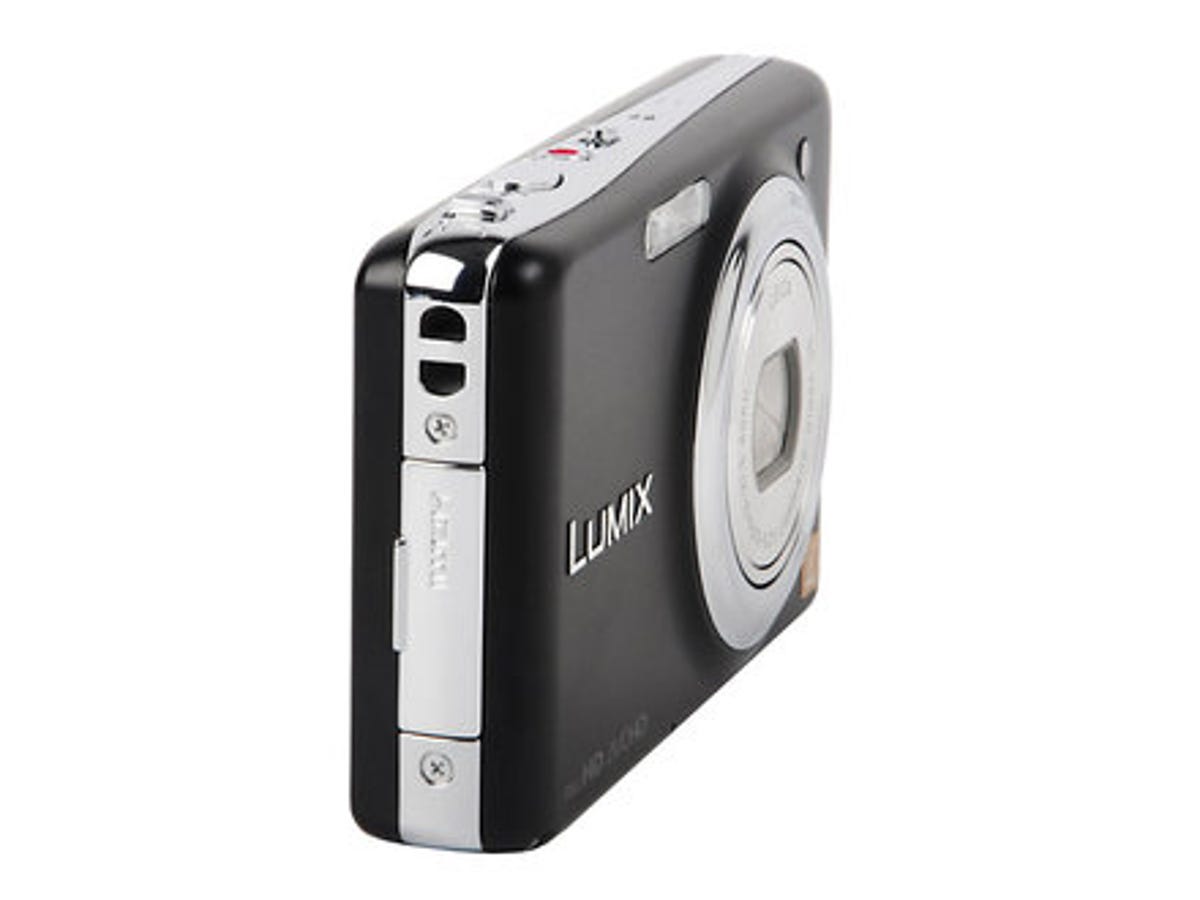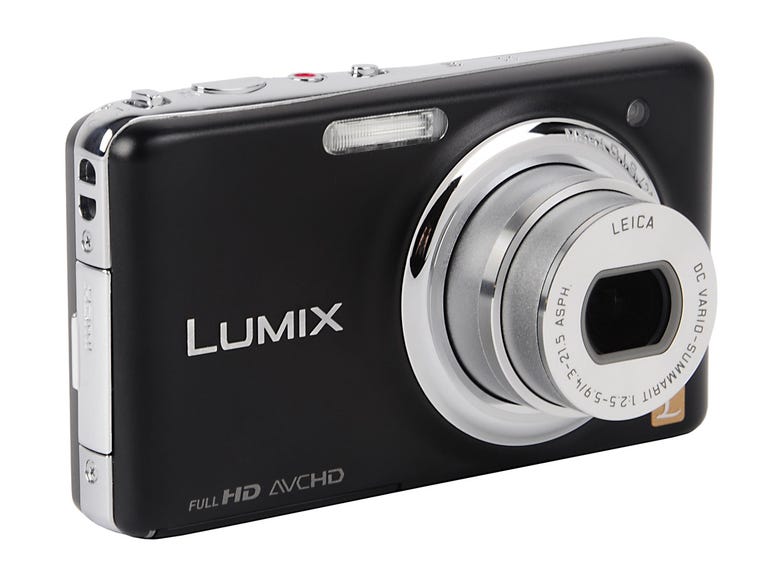 Why You Can Trust CNET
Why You Can Trust CNET Panasonic Lumix DMC-FX77 review: Panasonic Lumix DMC-FX77
The robust, slim body of the £185 Panasonic Lumix DMC-FX77 houses a 5x zoom, 12-megapixel sensor and super-sharp lens that produce impressive pictures.
You can often tell what a camera will do by the category it falls under: dSLRs offer unrivalled versatility; superzooms suit the more ambitious amateur; and ultra-compact snappers are great for taking to the pub or beach. Then we have the cameras that sit in the middle ground, which is where we find the Panasonic Lumix DMC-FX77.
The Good
The Bad
The Bottom Line
It's trim but not tiny and has a good zoom and a great lens, even though it isn't aimed at the pros. Around the back there's an impressive touchscreen display, which Panasonic hasn't made the camera's major selling point. Why? Because there's so much else to love about this slimline, unfussy device, as our tests quickly revealed.
It's available to buy from £180.
Build and specs
The case is largely featureless, with a gently curved front and a flat back covered almost entirely by a bright, wide touchscreen. You use this not only to frame and review your shots, but also to navigate the menus and controls by touch. Aside from the touchscreen there's only a power switch, separate shutter releases for stills and video and the zoom rocker. The latter is supplemented by an on-screen equivalent for those who'd rather steer clear of physical buttons.
This all sounds very neat, but in practice it's not that comfortable to use. The physical buttons are small and fairly unresponsive, with a definite click to the power switch and a slow zoom on the rocker. What's more, the lack of any obvious ridges or notches makes the Lumix DMC-FX77 harder to hold than it ought to be. Clutching it out over tall drops or water made us nervous.

The screen itself has one of the more responsive touch interfaces we have encountered. The menus are chunky and easy to prod with a fat finger. On the whole, they're well thought out, but we'd have appreciated some common features, such as macro -- which would otherwise have been a single click away on a camera with buttons -- being moved to the top of the stack.
Other than that, the build quality can't be faulted. The case is metal on five sides with touch plastic on the back. The 5x zoom -- equivalent to 24-120mm in a 35mm camera -- is extremely quiet. The battery and SD/SDHC/SDXC media cards are loaded through the underside, the door for which is sufficiently offset from the tripod screw not to be obstructed when the camera is mounted.
Stills performance
The Lumix DMC-FX77 has a 12.1-megapixel sensor. If you were to rank the current crop of new digital compacts by resolution, that would put it towards the lower end of the pack. It's important to point out, though, that resolution has very little to do with image quality. A slightly lower pixel count will usually deliver superior results as each photosite on the sensor can be physically larger; this makes it more sensitive to low light and less likely to become overloaded in brighter conditions.
We weren't surprised, then, to see the Lumix DMC-FX77 put in a good performance throughout our tests.
In regular shooting, minimum focusing distance stands at 50cm with the lens fully retracted; it's twice that at full telephoto. In macro mode, whether invoked manually or by the camera when set to Intelligent Auto mode, this drops to a more respectable 3cm.
This was enough for us to shoot some great close-up subjects. The spines of the teasel in the image below are clearly defined at the top of its head, and a rapid fall-off in the focus below and beyond it draws the eye towards the subject in the frame. This was helped greatly by the Lumix DMC-FX77's wider than average maximum aperture of f/2.5 in wide angle. If used when shooting portraits, this will help to achieve a more professional result. At the other end of the scale -- telephoto -- the maximum aperture tops out at a more common f/5.9.
At less extreme distances, the Lumix DMC-FX77 produced well detailed shots with a longer depth of field when it detected that subjects were further from the lens. In the image below, the metering point was at the furthest end of the bridge; by setting the aperture to a narrower f/8, focus is maintained right up to the closest struts and supports.
There was very slight evidence of clipped highlights on the facing edges of the painted ironwork, which had directly reflected the ambient light into the lens. Otherwise the scene was evenly exposed for a very balanced result overall.
The Lumix DMC-FX77 made excellent use of narrow palettes when rendering detail in areas dominated by one particular colour. In the image below we have two areas in which this is the case: among the foliage on the bank to the left and the surface of the water. In each instance, the Lumix DMC-FX77 has packed these areas with detail; there are subtle ripples on the surface of the canal and a striking contrast among the leaves, which are cleanly rendered, without any evidence of noise.
The Lumix DMC-FX77 is fronted by a sharp Leica-built lens, which does an excellent job of focusing each tone of incoming light accurately on the sensor. In some cameras we occasionally see evidence of the colours that make up the visible light spectrum being split as they pass through the lens -- as they do with a prism -- and focused in slightly different places on the sensor, resulting in a fringed effect called chromatic aberration. This most often manifests itself on sharp contrasts and fine detail, such as window frames and branches passing over brighter backgrounds.
In the image below, such fine details were cleanly rendered, with the grass that encroaches on the lighter sky retaining sharp edges and fine definition.
Detail remained sharp right into the corners and edges of our shots; we might have expected to see some deterioration due to the angle through which the incoming light must be bent to focus on the sensor, as can be seen in the detailed image below. There was also no evidence of any vignette effect -- a darkening of the extreme corners -- as can sometimes occur when a lens is set to full telephoto.
The Lumix DMC-FX77 made excellent use of the available light throughout our tests to minimise its self-selected sensitivity, thus keeping noise under control while rendering bright, vibrant colours. This can be seen clearly in the shot of the boat below, which was exposed at ISO 100 as the sun started to fade.
Although not pitting them head-to-head, we tested the Lumix DMC-FX77 alongside other cameras, including the Fujifilm FinePix F600EXR. The Lumix DMC-FX77 had no trouble exposing this image using its regular settings. However, the Fujifilm trimmed its resolution to just 8 megapixels in an effort to cut the amount of noise introduced into the frame when it increased its sensitivity to between ISO 125 and ISO 160 on each shot. Even then, its colours weren't as bright as those seen here on the Lumix DMC-FX77, making this Panasonic one of the best compact cameras we have used for general-puspose photography.
Turning to our indoor still-life test in which we shoot an arrangement of everyday objects with varying colours and surface textures, the Lumix DMC-FX77 put in one of the best performances we have seen under studio lighting. Levels of detail were very high, with clear stitching in fabric, smooth grain in wood and well-handled reflections from brushed aluminium and glassy surfaces such as the front of an iPod nano. Text was captured with great clarity, with sharp, well-defined edges to each character.
It upped its sensitivity from ISO 100 to ISO 400 when we switched off the studio lights, but this barely made any difference to the level of detail captured. Noise was kept to an absolute minimum and colours remained true to their originals.
However, when we forced the flash to fire, the scene was spoiled by harsh shadows behind our objects; the direct artificial lighting also removed much of the subtlety from the colours.
Video performance
The Lumix DMC-FX77's video recording options are slim. You can activate wind noise cut, overlay the screen with one-third guide lines and apply scene modes. Other than that you'll have to stick with the defaults.
The quiet zoom came into its own here, allowing us to change the composition of our movie without its movement being audible on the soundtrack. Focal correction was quick and well handled. The Lumix DMC-FX77 compensated for changes in the focal point in less than a second, both when zooming and panning across a scene.
Colours were a little washed out when compared with our stills images, but on the whole, its video output was a worthy complement to its static shots.
Conclusion
The Lumix DMC-FX77 is smart and surprisingly compact. It's thin enough to slip easily into a pocket. But while the lack of any bumps or ridges helps in this respect, we remain concerned that the sleek body counts against it when it comes to general handling.
However, it has one of the best implemented touchscreens we have come across on a device in this class. The dumpy, unrefined menus prove to be a triumph. Panasonic has resisted the urge to make a pretty interface and instead implemented something that's truly fit for purpose.
A smart interface, sturdy build quality and first-class output earn the Lumix DMC-FX77 close to top marks in our final analysis, putting it among the best compact cameras currently on sale.


